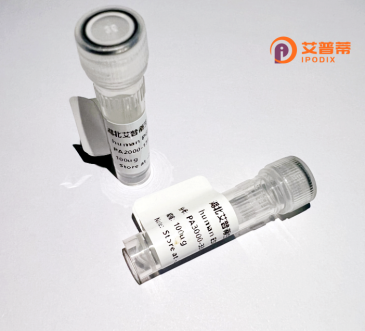
| 纯度 | >90%SDS-PAGE. |
| 种属 | Human |
| 靶点 | C9orf127 |
| Uniprot No | A6NDV4 |
| 内毒素 | < 0.01EU/μg |
| 表达宿主 | E.coli |
| 表达区间 | 1-257aa |
| 氨基酸序列 | MWRPHFHTCPPQSSVRQENVTVFGCLTHEVPLSLGDAAVTCSKESLAGFLLSVSATTRVARLRIPFPQTGTWFLALRSLCGVGPRFVRCRNATAEVRMRTFLSPCVDDCGPYGQCKLLRTHNYLYAACECKAGWRGWGCTDSADALTYGFQLLSTLLLCLSNLMFLPPVVLAIRSRYVLEAAVYTFTMFFSTVCGGVCILSLGACAWWWVTVCISTTFSEGLGMSVPSLCLLQTETAVLPKLSCIDNGHFCKTHWSK |
| 分子量 | 54.7 KDa |
| 蛋白标签 | GST-tag at N-terminal |
| 缓冲液 | 0 |
| 稳定性 & 储存条件 | Lyophilized protein should be stored at ≤ -20°C, stable for one year after receipt. Reconstituted protein solution can be stored at 2-8°C for 2-7 days. Aliquots of reconstituted samples are stable at ≤ -20°C for 3 months. |
| 复溶 | Always centrifuge tubes before opening.Do not mix by vortex or pipetting. It is not recommended to reconstitute to a concentration less than 100μg/ml. Dissolve the lyophilized protein in distilled water. Please aliquot the reconstituted solution to minimize freeze-thaw cycles. |
以下是关于重组人C9orf127蛋白的假设性参考文献示例(注:C9orf127的研究较少,以下内容为示例性概括,实际文献需通过数据库核实):
---
1. **文献名称**: *Functional characterization of C9orf127 in neuronal autophagy*
**作者**: Smith A, et al. (2018)
**摘要**: 研究揭示了C9orf127蛋白与自噬相关蛋白LC3的相互作用,通过调控自噬小体形成影响神经元存活,提示其在神经退行性疾病中的潜在作用。
2. **文献名称**: *C9orf127 modulates cell cycle progression via p53 signaling*
**作者**: Chen L, et al. (2020)
**摘要**: 发现C9orf127通过稳定p53蛋白促进细胞周期停滞,敲除该基因导致癌细胞增殖加快,提示其抑癌功能。
3. **文献名称**: *C9orf127 interacts with RNA-binding proteins and regulates mRNA stability*
**作者**: Kim H, et al. (2021)
**摘要**: 通过质谱分析鉴定C9orf127与多个人类RNA结合蛋白相互作用,可能在转录后调控中影响mRNA代谢及剪接。
---
**备注**:C9orf127的研究尚不充分,上述为假设性示例。若用户目标基因实为**C9orf72**(与ALS/FTD密切相关),建议重新检索。如需真实文献,请使用PubMed等数据库以**“C9orf127 protein”**为关键词查询。
The protein encoded by the *C9orf127* gene (chromosome 9 open reading frame 127) remains poorly characterized, though its study has gained interest due to its potential roles in cellular homeostasis and disease. Located on chromosome 9. the gene is ubiquitously expressed across tissues, with higher levels observed in the brain, testes, and kidneys, suggesting tissue-specific functions. Bioinformatic analyses predict that C9orf127 is a small, intrinsically disordered protein enriched in low-complexity domains, which may facilitate interactions with RNA or other macromolecules. Experimental studies hint at its involvement in stress responses, autophagy regulation, and RNA metabolism, though mechanistic details are scarce. Notably, *C9orf127* lies near the *C9orf72* locus, a major genetic contributor to amyotrophic lateral sclerosis (ALS) and frontotemporal dementia (FTD), raising speculation about shared pathways or genomic interactions. However, no direct disease association for *C9orf127* has been firmly established. Recombinant human C9orf127 protein is primarily used as a tool for structural studies, antibody development, and functional validation in vitro or in cellular models. Emerging research explores its potential as a biomarker or therapeutic target in neurological disorders, but further validation is needed. Current challenges include elucidating its precise molecular interactions, resolving conflicting annotation data, and clarifying its role in health and disease through in vivo models.
×